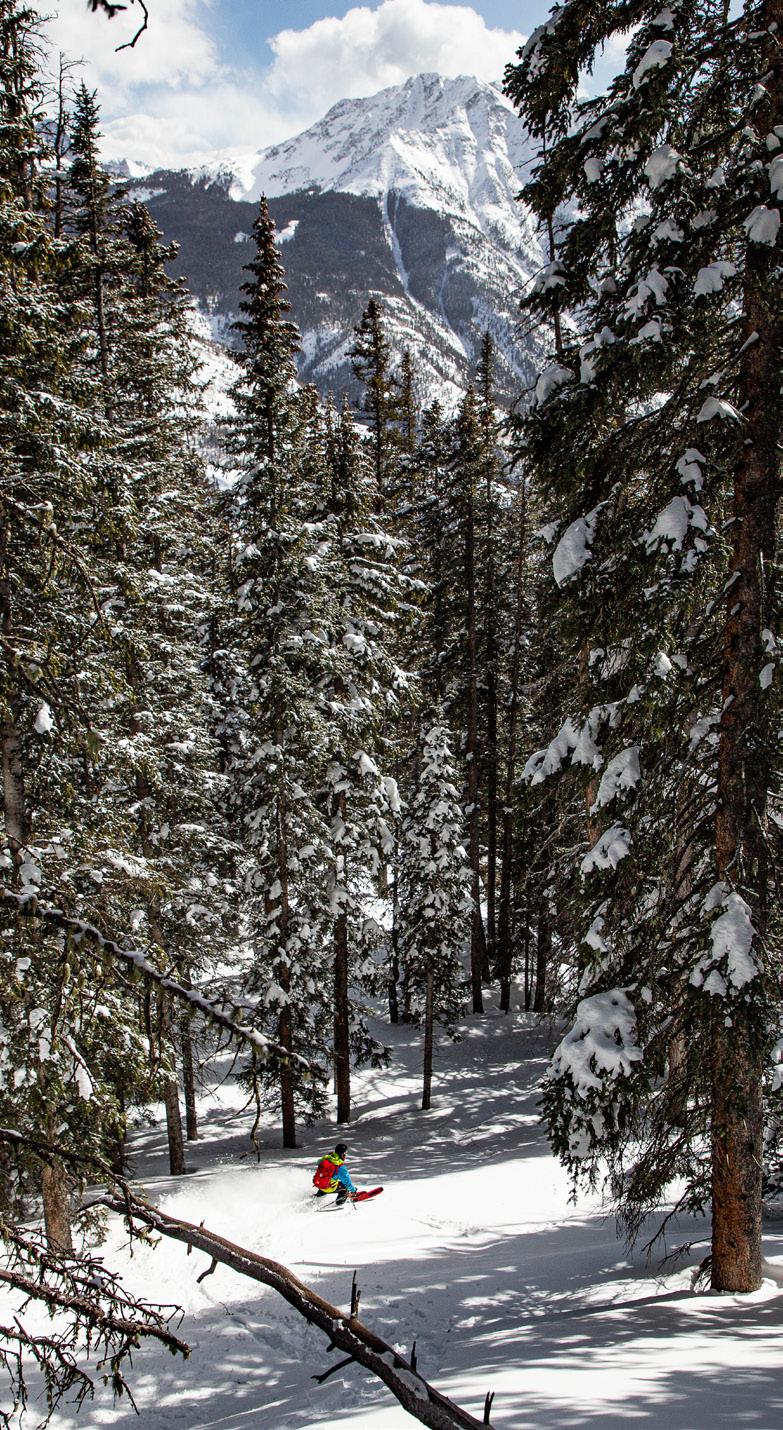
4 minute read
OUTDOOR VITALS
The dense green of spruce-fir forest is a wall of living trees. Such impenetrable forest is daunting to imagine a ski line through. photo by Mike Remke
High Elevation Forests The important role trees play in backcountry skiing
BY MIKE REMKE
SNOW SCIENTIST
Brushing away at layers of snow and examining the crystal structure of ice within the matrix of ice, water and gas has always felt like the most tangible way to bring science to the masses. Winter introduces a world where backcountry skiers are all scientists — from reading avalanche reports and monitoring weather data at various locations, to digging snow pits and conducting avalanche stability tests.
The ritual of digging snow pits by backcountry skiers is the largest shared field science I have participated in. Science is, at its core, a way of knowing. The scientific method of making observations, developing hypotheses, collecting data and analyzing results is the absolute reality of backcountry skiing. For most, the research and engagement in snow science revolves around a simple question: “What slopes are reasonably safe to ski today?” While the question may be simple, the process is a beautiful deep dive in science.
Conversations revolve around using data to make informed decisions. All of this information is buzzing around with a focus on snow, answering the question about what slopes are desirable to ski — but wait, did someone say something about trees? THE FOREST
In the San Juan Mountains, no matter how you plan your ski day, you will end up in forest. While no less mystic than the world of snow science, forest science is rich with intricate patterns and details. Much of Southwest Colorado’s backcountry skiing lands itself in the high elevation forest types of spruce-fir or aspen. These forests are dominated by subalpine fir and Engelmann spruce where they tend to have a dense, closed canopy that is difficult to ski — unless there is some sort of disturbance. One of the most obvious connections of forests and snow is how the phenomenal force of snow can influence forests.
Some of the most desirable forested ski runs in the backcountry are shaped by the exact phenomena we use snow science to mitigate risk of: avalanches. These obvious and abundant paths in the San Juans are a disturbance that is critically important in shaping the ecology of high elevation forests. They prompt succession to occur, creating areas where willows or aspen may be more abundant than other species, making avalanche paths choice habitat for moose and elk. These disturbances that are obvious to snow scientists are just one of the many patterns explored in forest science through backcountry skiing.
If the question is about skiable slopes, then snow is clearly the first layer in the conversation. However, forest ecology is an equally important perspective. From species compositions to relationships with insect and disturbance history, forest ecology contributes to desirable slopes for skiing.
INSECTS
Anyone who has toured Lobo Overlook near Wolf Creek is familiar with the sea of gray from the spruce bark beetle outbreak. These native insects have responded to warmer temperatures, impacting huge swaths of forest by killing overstory trees. The result is a forest that is much more open with many ski lines, and sometimes even more snow accumulation and fewer tree wells.
Perhaps a much less obvious insect is that of the spruce budworm. This small worm feeds on the green needles of trees and prefers the shady understory. Thus, it often consumes the green needles of lower branches of spruce and fir trees leaving the lower branches bare and defoliated. In place of the green branches, old man’s beard, or Usnea, often thrives on the branches. These Usnea-draped branches are far less dense and more skiable than the dense closed canopy of unaltered spruce-fir forests making for fun, but still tight, tree skiing. FIRE
Fires in the spruce-fir forests are rare, operating on timescales that outlast the human lifespan, but they do occur. Every 100-500 years, prolonged drought and elevated temperatures visit these environments, drying out the forest enough for it to burn. Fires of the past have shaped where we find aspen, which sprouts vigorously after fire, creates openings and alters the landscape to influence the slopes we find desirable to ski.
FOREST SCIENTIST
With so many rich patterns shaping where we decide to ski, backcountry skiing becomes an opportunity for all of us to be scientists of the snow and the forests. Understanding how forest ecology interacts with snow will help us all better predict and understand snow conditions. Simultaneously, paying attention to the forest will help us all understand how the forest is responding to a changing world. By backcountry skiing and paying attention, we can all be ecologists.
MIKE REMKE is a professor of biology at Fort Lewis College and a research associate with Mountain Studies Institute. When he is not busy being a nerd, Mike is often out and about with his camera, bike or splitboard enjoying the rich scenery of the San Juans.
Skiing in the Deer Creek drainage can be a maze, but with many spruce impacted by spruce budworm, the removal of the dense green foliage provides some clear lines and fun glade skiing. photo by Mike Remke












